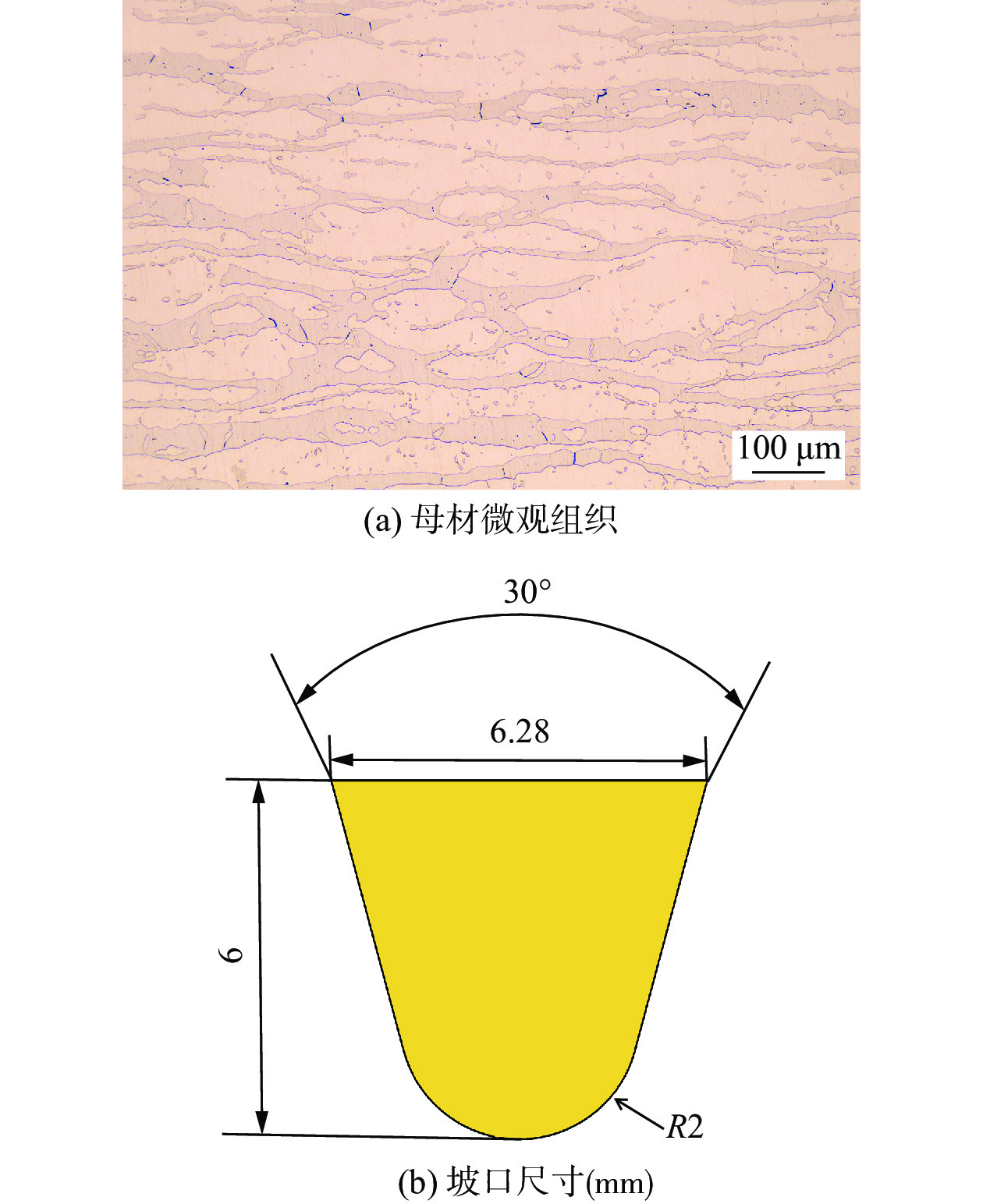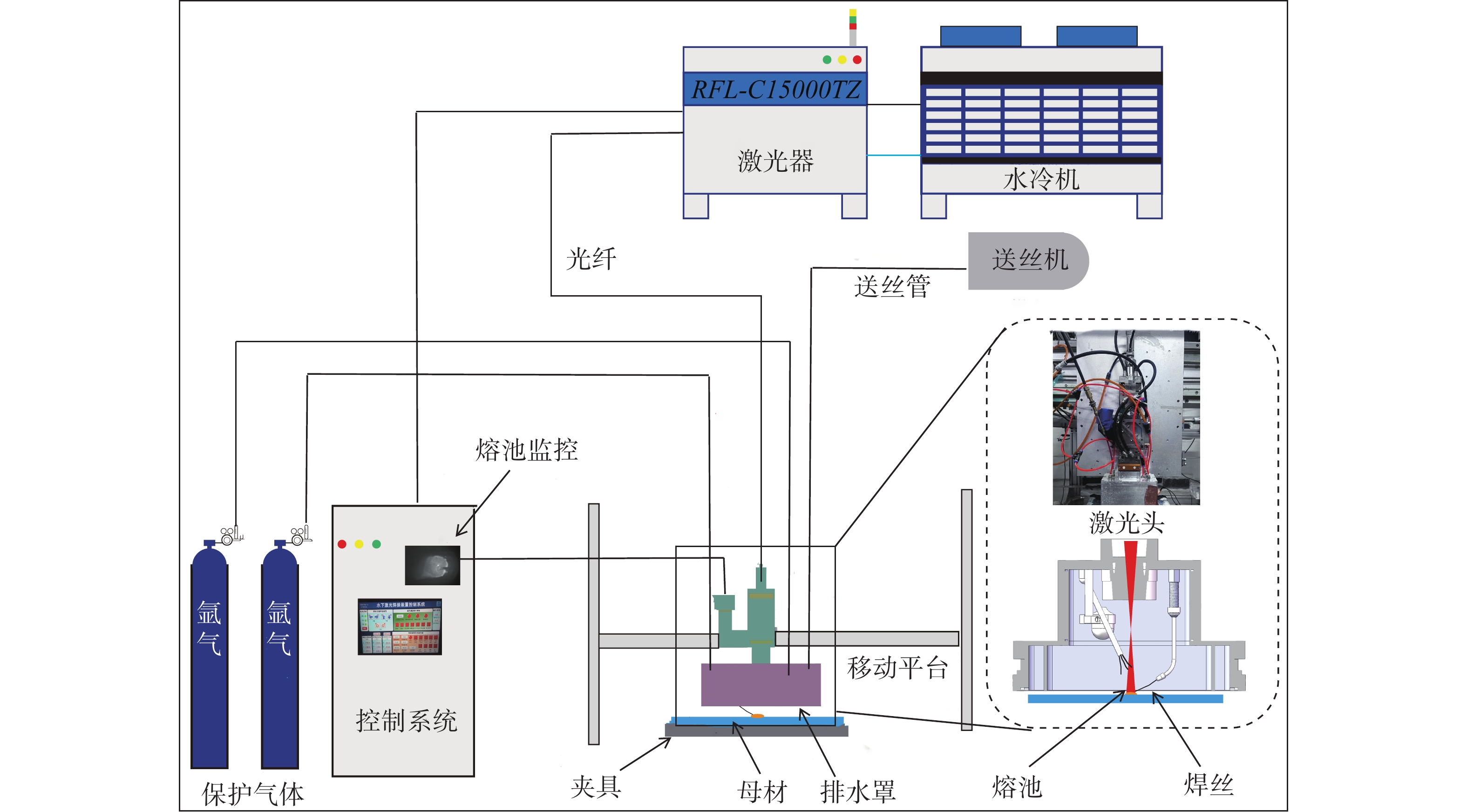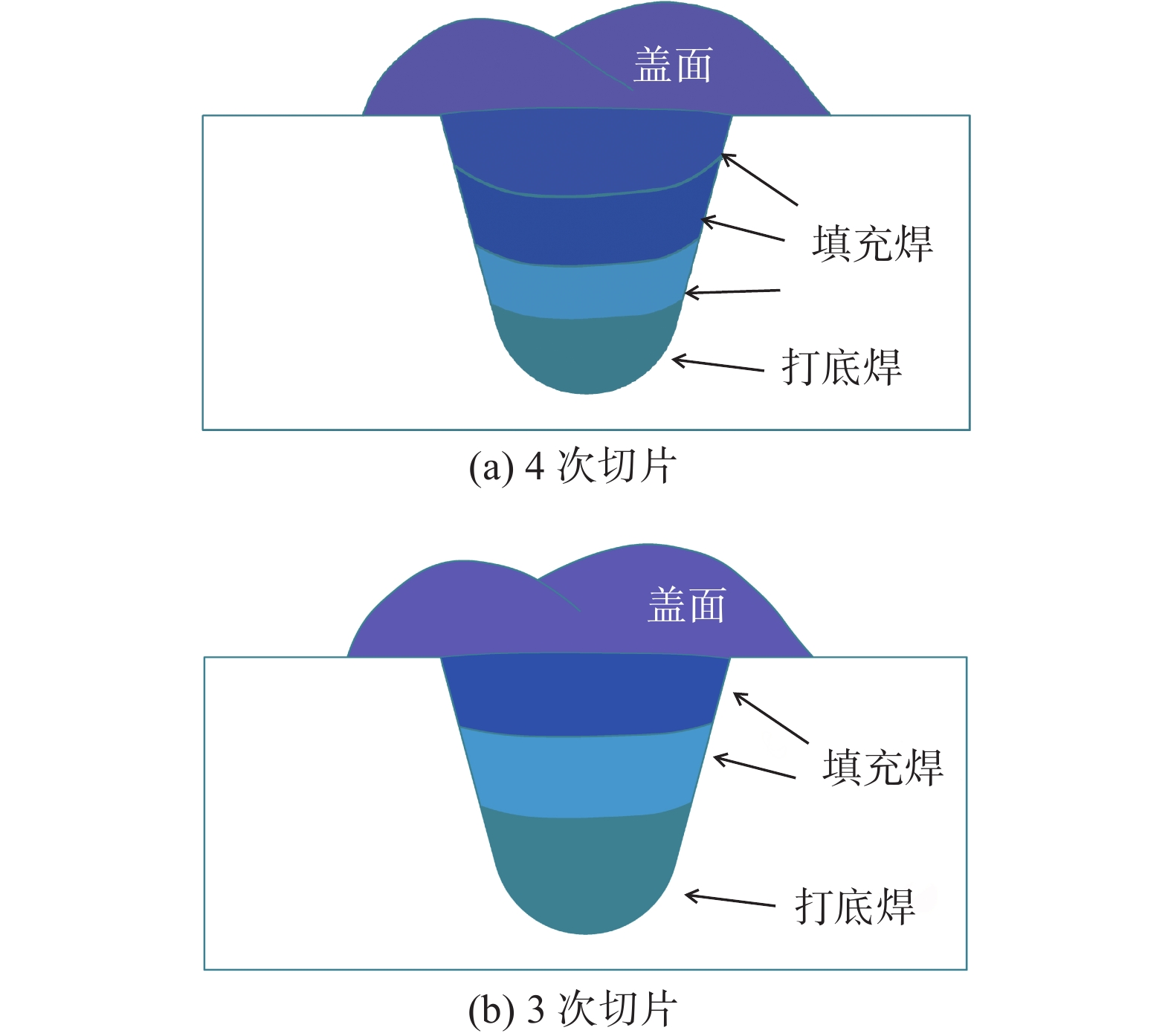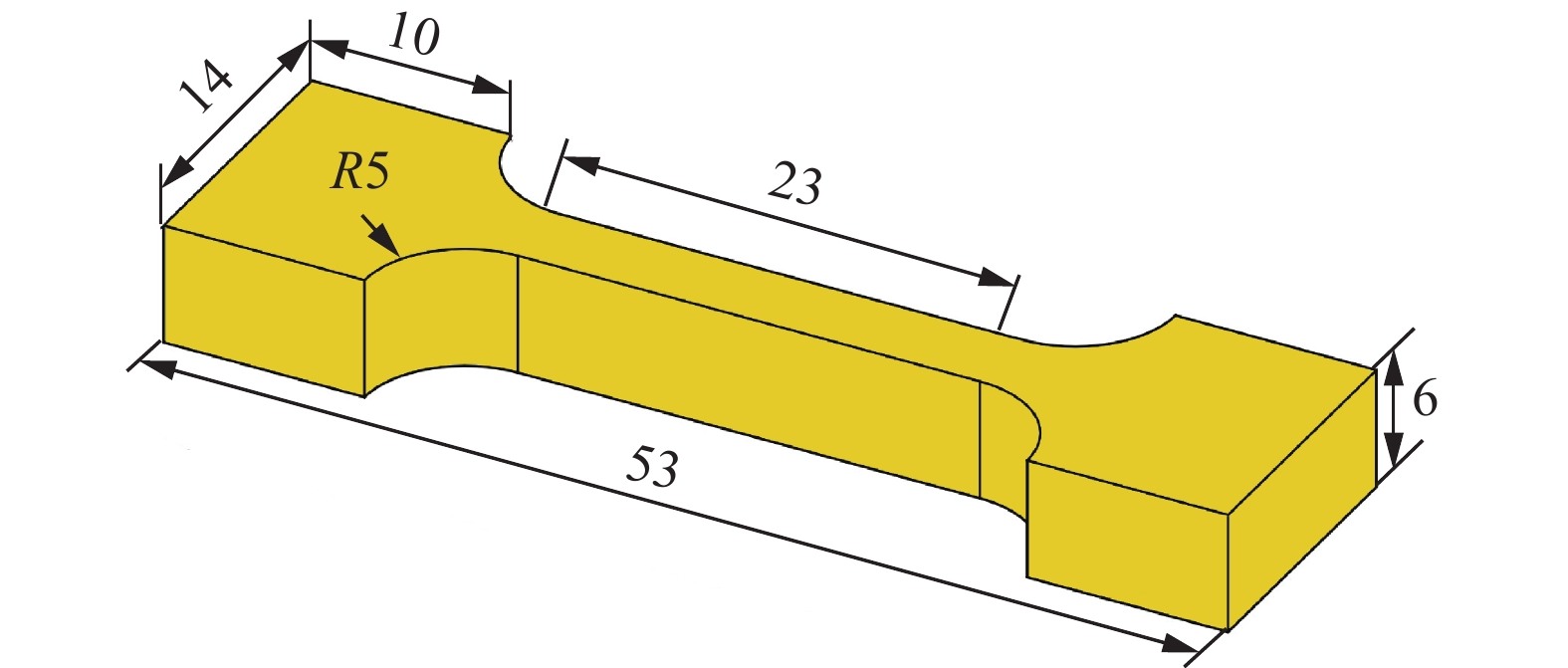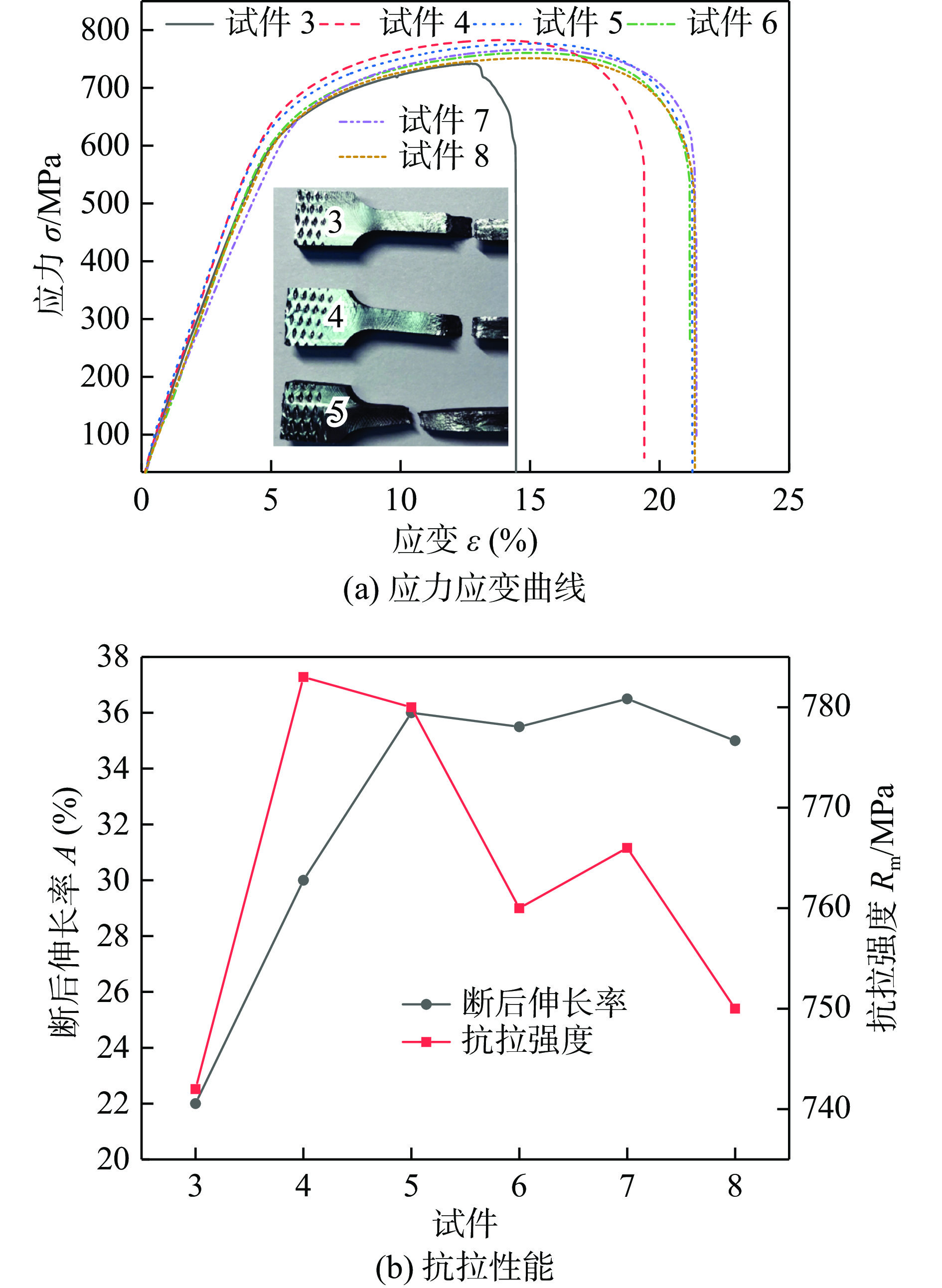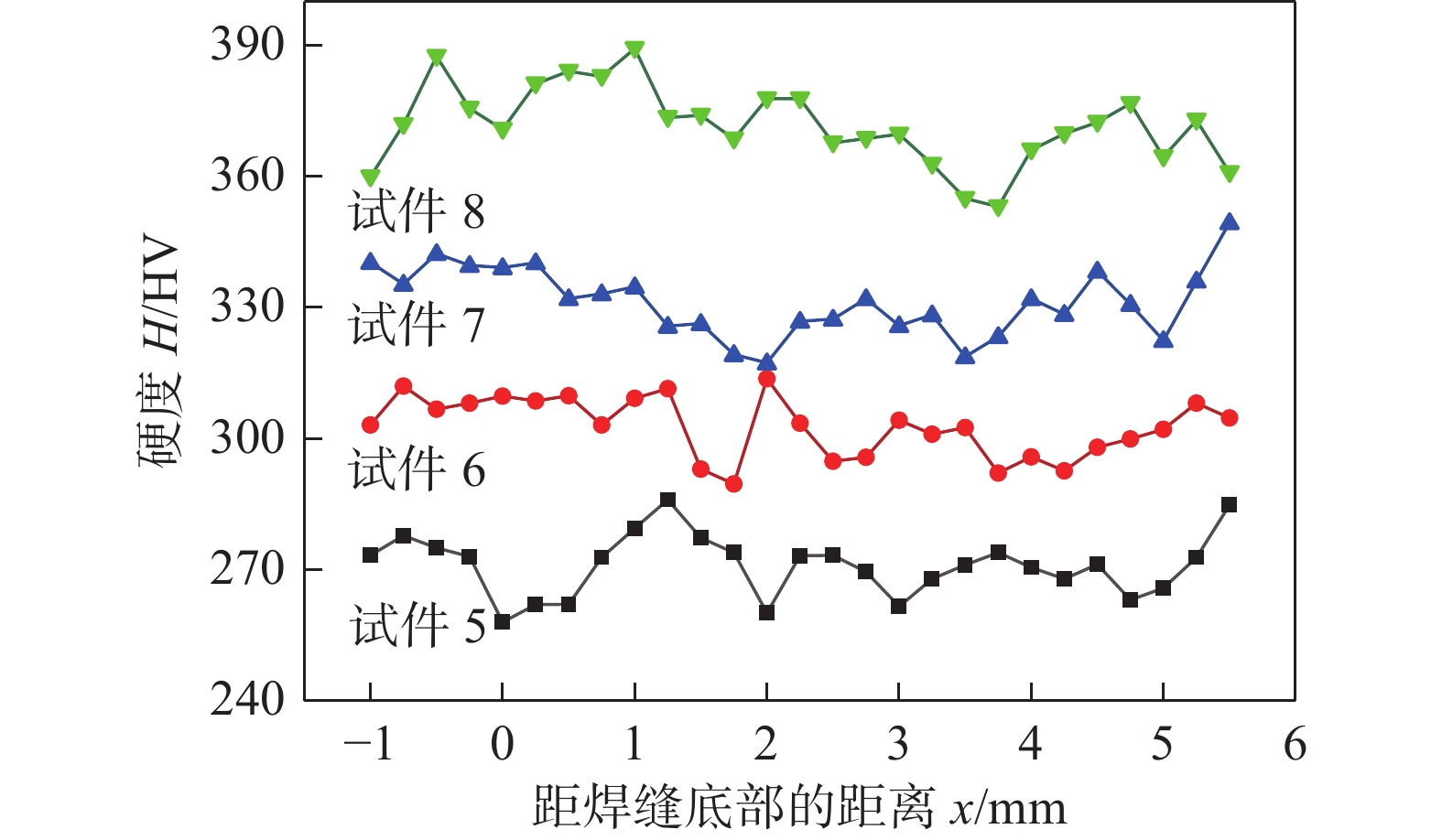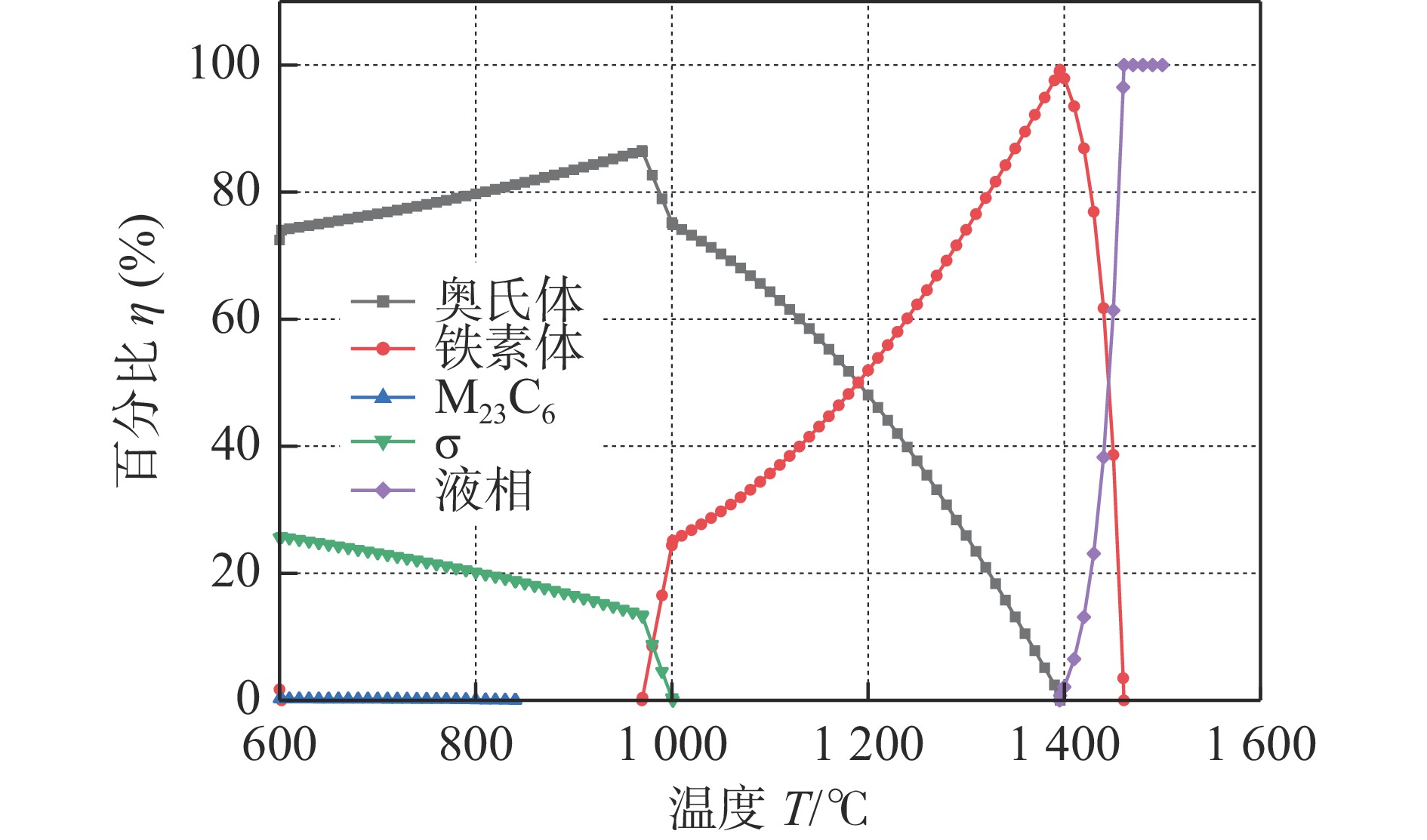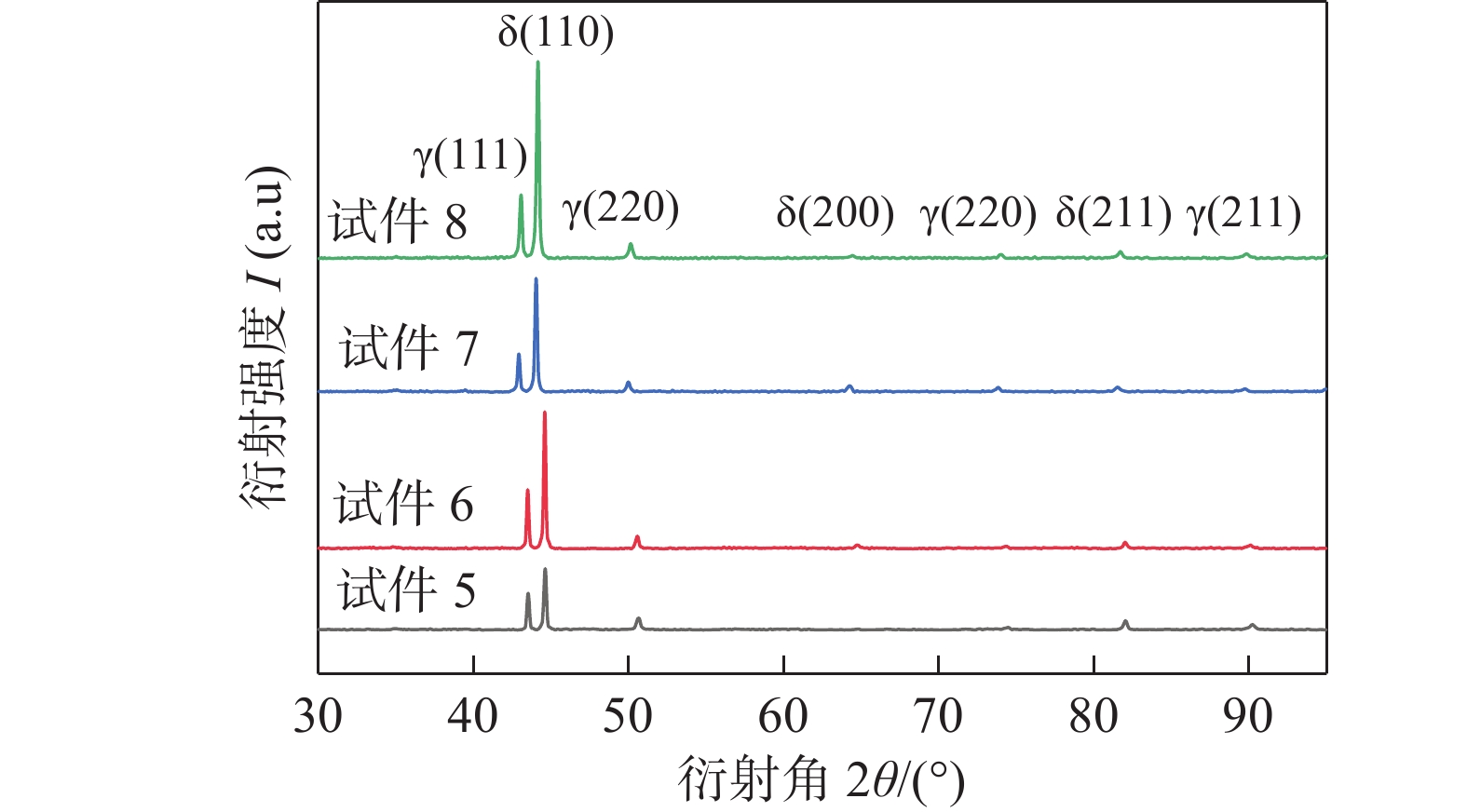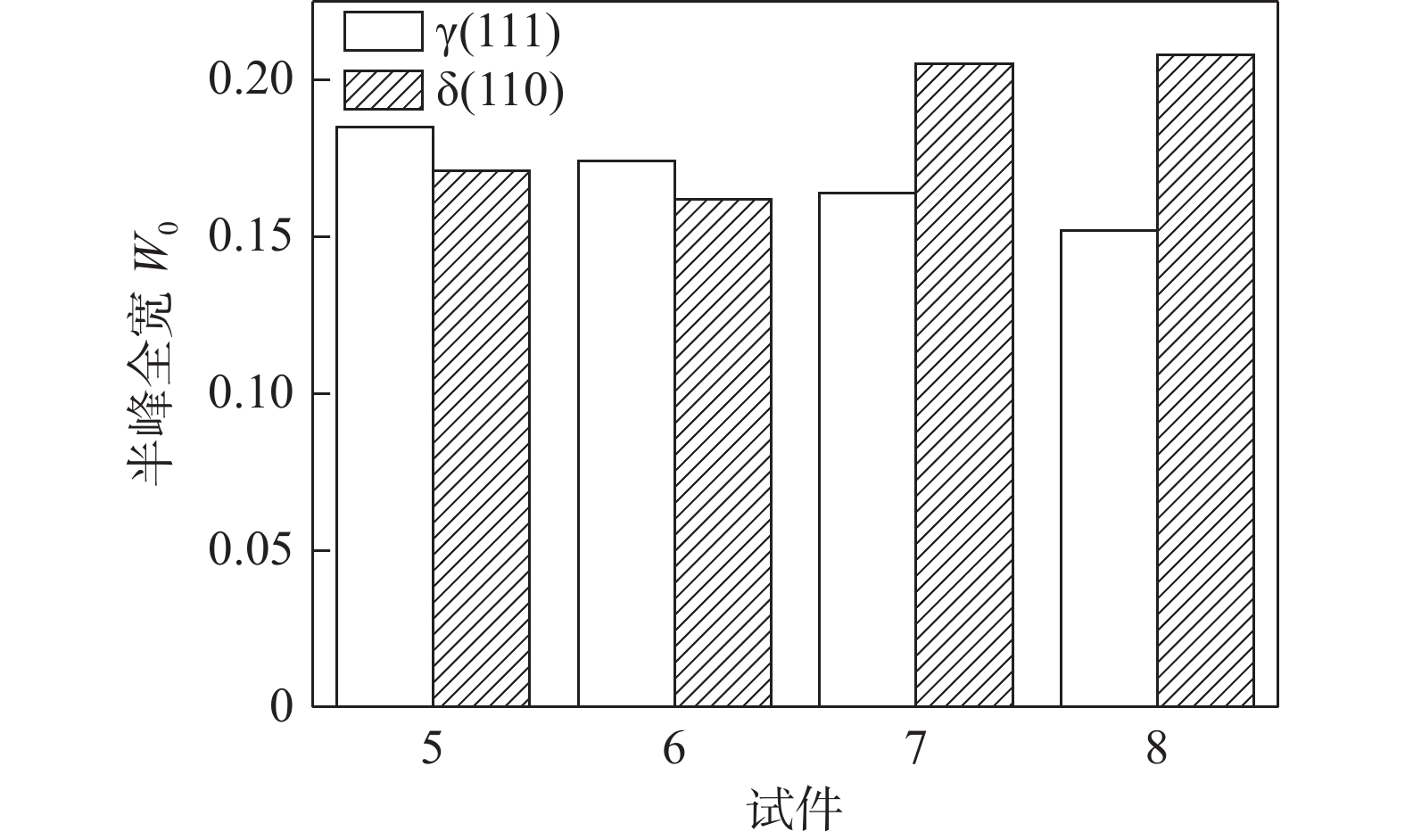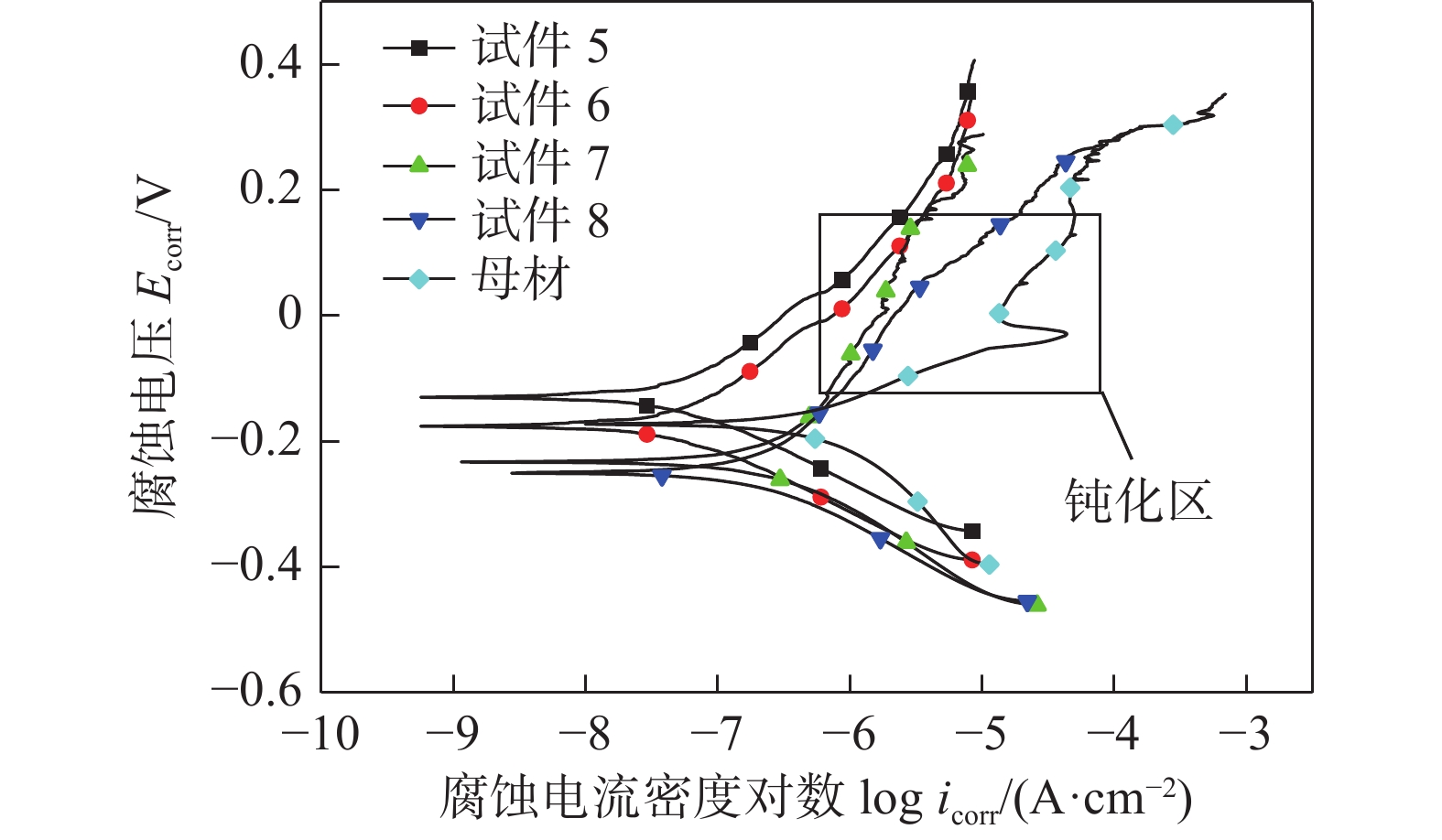Laser filling welding repair process for U-shaped groove of S32101 duplex stainless steel
-
摘要:
文中采用开设坡口的方式去除裂纹、通过坡口填充焊接修复的方式进行维修,在空气环境中开展了S32101双相不锈钢激光填丝焊接修复工艺试验研究,焊接工艺及相关参数可以作为水下焊接研究的参考依据. 为避免过高激光功率输入损坏焊接辅助装置,在
5000 ~6000 W激光功率的工艺窗口下,对开设的坡口进行了3次填充修复及4次填充修复,对焊缝截面、显微组织、力学性能以及耐腐蚀性能分别进行了研究. 在试验过程中,采用了光学显微镜和扫描电镜等,分析了焊接过程中热输入对微观组织转变的影响. 同时通过对比不同激光功率下焊缝的拉伸性能和显微硬度,进一步揭示了工艺参数对焊缝力学性能和耐腐蚀性能的具体影响,从而优化了修复工艺的稳定性和可靠性. 结果表明,3次填充修复后的焊缝存在气孔以及冶金熔合不良等问题,4次填充修复后的焊缝截面未见气孔缺陷,拉伸试件断在母材位置. 层间焊道的预热和再热促使焊缝中奥氏体析出,焊缝中奥氏体含量略高于铁素体含量,平均硬度略低于母材. 焊缝中较高含量的Ni元素和Mo元素使得焊缝的耐腐蚀性能优于母材,4次填充修复得到的焊缝满足空气环境中修复质量标准要求.-
关键词:
- 激光焊接 /
- S32101双相不锈钢 /
- 微观组织 /
- 耐腐蚀性能 /
- 显微硬度
Abstract:In this paper, cracks were removed by beveling, and repairs were performed using groove-filling welding techniques. An experimental investigation of laser wire-filling welding repair of S32101 duplex stainless steel in an air environment was conducted. The welding procedure and related parameters may serve as a reference for underwater welding studies. To prevent damage to the welding auxiliary equipment caused by excessive laser power input, comparative experiments were performed with three filling repairs and four filling repairs under a process window of
5000 ~6000 W laser power. The cross-sections, microstructure, mechanical properties, and corrosion resistance of the welds were thoroughly analyzed. During the experiments, optical microscopy and scanning electron microscopy were used to examine the effects of heat input during welding on microstructural transformations. Additionally, by comparing the tensile properties and microhardness of welds at different laser power levels, the specific influence of process parameters on the mechanical properties and corrosion resistance of the welds was further elucidated, thereby optimizing the stability and reliability of the repair process. The results showed that the welds repaired with three filling repairs exhibited issues such as porosity and poor metallurgical fusion, whereas the cross-sections of the welds repaired with four filling repairs showed no porosity defects, and the tensile specimens fractured at the base metal. Preheating and reheating of the interpass welding promoted the precipitation of austenite in the welds, and the austenite content was slightly higher than that of ferrite, with the average hardness being slightly lower than that of the base metal. The higher Ni and Mo content in the welds contributed to superior corrosion resistance compared to the base metal. The welds repaired with four filling repairs met the quality standards for repairs conducted in an air environment. -
0. 序言
异种金属钛/钢焊接结构兼具了两者的高比强度、低质量、优异的耐腐蚀性和满意的经济性等优点,被广泛应用于海水冷热交换器、涡轮喷气发动机压气机和燃烧室之间的连接等[1-3]. 但是由于钛和铁之间的物理性能存在较大的差异,如热导率、线膨胀系数等,在焊后冷却过程中收缩不均匀,导致接头中存在较大的焊接应力[4]. 另一方面,当钛/钢直接熔化焊时,焊缝中含Fe量大大超过在Ti中的溶解度范围[5],焊后接头中存在大量硬脆的Ti-Fe金属间化合物(600 ~ 1050 HV)[6]. 因此钛/钢异种金属直接焊接后,接头的力学性能很差. 关于改善钛/钢异种金属焊接接头力学性能方面的研究有很多. 主要通过合适的焊接方法[7-8]和添加中间填充金属[9-15]来抑制硬脆的Ti-Fe金属间化合物的生成,进一步改善接头的力学性能. 很多学者主要研究钛/钢异种金属焊接接头的力学性能. 对钛/钢接头的耐腐蚀性能的研究相对较少. 因此研究异种金属接头的耐腐蚀性很有必要. 目前主要研究铝/钢[16-17]、铝/铜[18-19]、铝/钛[20-21]、镁/铝[22-23]、镁/钢[24-25]以及钛/钢[26-27]等异种金属接头的耐腐蚀性. 结果表明,异种金属接头在特定的溶液中腐蚀后发生了电偶腐蚀.
关于钛/钢异种金属接头的耐腐蚀性研究相对较少. 文中采用铜基填充金属对Ti6Al4V钛合金/304不锈钢进行冷金属过渡(CMT)搭接焊接. 一方面是Ti与Cu发生反应,生成硬度相对较低的Ti-Cu金属间化合物(500 ~ 600 HV),此外铜具备良好的塑性和延展性,可以缓解接头中的焊接应力[28]. 另一方面是选用热输入较低的冷金属过渡技术进行钛合金、不锈钢焊接,以减少金属间化合物的生成[29]. 焊后分析了接头的显微组织及形成过程,评定了接头的力学性能,研究了接头的腐蚀性能. 研究内容有望为钛/钢异种金属焊接接头的性能改善提供理论基础.
1. 试验方法
试验采用直径为1.2 mm的ERCuNiAl铜合金焊丝对TC4钛合金(TC4)和304不锈钢(304 SS)进行CMT搭接焊接. 其中钛合金板和304不锈钢板的尺寸均为100 mm × 50 mm × 1 mm. 其化学成分如表1所示.
表 1 材料的化学成分 (质量分数/%)Table 1. Chemical compositions of materials (wt. %)材料 Cr Ni Si Mn C Fe Al V N H O Ti Pb Zn Cu 304 SS 18.0 ~ 20.0 8.0 ~ 12.0 1.0 2.0 ≤ 0.03 余量 TC4 0.1 0.3 5.5 ~ 6.8 3.5 ~ 4.5 0.05 0.01 0.2 余量 ERCuNiAl 6.0 1.0 8.0 0.038 0.003 余量 试验采用冷金属过渡一元程序(CMT 3200,福尼斯,奥地利)进行搭接焊. 焊接前,先用丙酮对TC4钛合金板待焊面进行清洗,再用钢丝刷打磨,然后分别用5% ~ 10%氢氧化钠溶液和30%硝酸溶液清洗5 min,再用自来水冲洗,最后用酒精冲洗,吹干待用. 采用钢丝刷打磨304不锈钢板待焊表面,将处理好的不锈钢板放入酒精中超声清洗,最后吹干待用. 焊接时,采用不锈钢板放置在上面,钛合金板放置在下面的搭接方式,搭接量为10 mm,如图1所示. 焊接速度为8.53 mm/s,送丝速度为5.5 m/min (电流I=171 A,电压U=15.0 V). 过程中采用气流量为15 L/min的高纯氩气.
焊接后,采用配备能谱仪(EDS)的扫描电子显微镜(SEM,FEG 450)对横截面接头的显微组织进行分析;在室温下采用拉伸机(AGS-X 300KN)测试接头的拉伸性能,拉伸速度为0.5 mm/min;采用维氏硬度计(HVT-1000A)测试接头的显微硬度,测试载荷为0.98 N,保载时间10 s;采用X射线衍射仪(XRD,D8Discover25)对断口物相组成进行分析;采用光镜(OM)对断口侧面进行分析.
对抛光后的试样进行浸泡腐蚀试验. 首先在腐蚀溶液中浸泡30天,然后采用SEM对腐蚀后接头的显微组织进行分析. 腐蚀溶液为人工海水,其配比为0.23 g MgCl2,0.33 g Mg2SO4,2.67 g NaCl和100 mL H2O.
2. 试验结果与分析
2.1 焊缝形貌
图2为TC4钛合金/304不锈钢搭接焊接接头的宏观形貌. 从图中可以看出,使用铜基填充金属对钛合金、不锈钢CMT焊接后,焊缝成形良好,表面无焊接缺陷,焊缝背面无明显的烧损.
2.2 显微组织
TC4钛合金/304不锈钢搭接焊接接头主要由焊缝金属、304 SS-铜焊缝界面(界面I)和TC4-铜焊缝界面(界面II)组成,如图3所示.
图4为焊缝金属、界面I和界面II的微观组织. 图中各个区域的EDS分析如表2所示. 图4a为焊缝金属的SEM图,主要由铜固溶体和α2相、Fe-Cr-Al-Cu-Ti-Ni化合物组成[5]. 图4b为靠近界面I处焊缝金属的SEM图,主要由铜固溶体和α2相、Fe-Cr-Al-Cu-Ni化合物组成[5]. 图4c为界面II的SEM图,从图中可以看出,TC4-Cu焊缝界面形成明显的界面反应层. 进一步对图4c界面反应层中的A,B和C区域放大分别如图4d,4e和4f所示. 结合EDS分析,界面反应层中的A区域主要由Ti-Cu-Fe化合物和Ti-Cu-Al化合物组成. 界面反应层中的B区域主要由Cu-Ti-Al-Fe化合物、Ti-Cu金属间化合物组成. 界面反应层中的C区域主要由Ti-Cu-Al-Ni-Fe化合物、Ti-Cu-Al化合物、Ti-Fe-Cr化合物组成,基体相由铜固溶体和α2相组成[5].
区域 Cu Al Ni Fe Cr Ti 1 77.4 14.6 3.3 3.0 0.8 0.6 2 7.0 9.9 4.5 54.8 16.2 6.5 3 76.0 13.8 4.5 4.3 0.7 0.5 4 7.6 9.0 5.0 60.5 15.5 1.1 5 22.4 8.8 2.9 13.1 2.6 49.6 6 22.5 12.3 2.1 2.0 1.0 59.9 7 17.3 11.1 2.2 7.9 2.9 57.9 8 32.6 16.2 5.0 12.6 1.5 31.7 9 27.3 9.7 2.5 6.8 1.7 51.8 10 81.9 12.7 1.0 1.6 0.6 1.4 11 19.0 20.9 18.5 15.4 1.0 24.9 12 8.1 5.5 2.0 27.3 14.4 39.0 13 49.6 14.3 3.1 3.4 0.9 28.4 图5为TC4钛合金/304不锈钢搭接焊接接头的形成过程,过程中的反应式如表3所示. 当CMT电弧的作用于铜基填充金属时,铜基填充金属完全熔化,304不锈钢母材部分熔化,TC4钛合金母材部分熔化,如图5a所示,液态熔池主要由Cu,Al,Ti,Fe,Cr和Ni元素组成,如表3中式(1)所示. 随着熔池温度的降低,焊缝金属、靠近界面I和界面II均发生反应,如图5b所示. 首先发生液相的分离,形成LCu,Al,LFe,Cr,Al,Cu,Ti,Ni,LFe,Cr,Al,Cu,Ni,LCu,Ti,Al,Fe,LTi,Cu,Al,Ni,Fe,LTi,Fe,Cr,LTi,Cu,Fe,LTi,Cu,Al和LTi,Cu相,如表3中式(2)所示. 由于电弧的搅拌作用,焊缝金属中的Fe,Cr,Al,Cu,Ti,Ni发生反应,如表3中式(3)所示,生成Fe-Cr-Al-Cu-Ti-Ni化合物. 靠近界面I处的焊缝金属中的Fe,Cr,Al,Cu,Ni发生反应,如表3中式(4)所示,生成Fe-Cr-Al-Cu-Ni化合物. 当温度降至1005 ℃时,LCu,Al发生反应,如表3中式(5)所示,生成铜固溶体和α2相[5]. 界面II处的反应层发生一系列反应,如表3中式(6) ~ 式(12)所示,生成各种金属间化合物. 最后液态金属凝固形成焊接接头,如图5c所示.
表 3 TC4/304 SS搭接焊接头形成过程中的反应式Table 3. Reaction formula during the formation process of TC4/304 SS lapped welding joint序号 反应式 1 Cu+Al+Ti+Fe+Cr+Ni→LCu,Al,Ti,Fe,Cr,Ni 2 LCu,Al,Ti,Fe,Cr,Ni→LCu,Al+LFe,Cr,Al,Cu,Ti,Ni+LFe,Cr,Al,Cu,Ni+
LCu,Ti,Al,Fe+LTi,Cu,Al,Ni,Fe+LTi,Fe,Cr+LTi,Cu,Fe+LTi,Cu,Al+LTi,Cu3 LFe,Cr,Al,Cu,Ti,Ni→Fe-Cr-Al-Cu-Ti-Ni化合物 4 LFe,Cr,Al,Cu,Ni→Fe-Cr-Al-Cu-Ni化合物 5 LCu,Al→β+Cu、β→γ1+Cu和Cu+γ1→α2 6 LFe,Cr,Al,Cu,Ti,Ni→Fe-Cr-Al-Cu-Ti-Ni化合物 7 LCu,Ti,Al,Fe→Cu-Ti-Al-Fe化合物 8 LTi,Cu,Al,Ni,Fe→Ti-Cu-Al-Fe-Ni化合物 9 LTi,Fe,Cr→Ti-Fe-Cr化合物 10 LTi,Cu,Fe→Ti-Cu-Fe化合物 11 LTi,Cu,Al→Ti-Cu-Al化合物 12 LTi,Cu→βTi+Ti2Cu、βTi→αTi+Ti2Cu 2.3 力学性能
图6为TC4钛合金/304不锈钢搭接焊接接头与纯钛/镀锌钢、纯钛/铜、钛合金/铜接头拉剪强度的对比图[30-32],从图中可以看出,纯钛/镀锌钢接头的强度最高,可达325 MPa,而钛合金/不锈钢接头的拉剪强度次之,为306 MPa. 纯钛/镀锌钢和钛合金/不锈钢接头的强度约为纯钛/铜、钛合金/铝接头强度的2倍.
图7为TC4钛合金/304不锈钢搭接焊接接头中沿界面I和界面II的显微硬度变化. 从图中可以看出,界面I的显微硬度变化不大,主要是因为无明显的反应层生成. 焊缝金属的显微硬度平均值为244 HV,显微硬度的变化主要是Fe-Cr-Al-Cu-Ti-Ni化合物的生成. 对界面II而言,界面反应层的显微硬度明显的高于焊缝金属和TC4钛合金母材的显微硬度,其最大值为600 HV. 主要是生成大量的Ti-Cu金属间化合物.
![]() 图 7 TC4/304 SS搭接焊接头的显微硬度变化Figure 7. Microhardness variation of TC4/304 SS lapped welding joint. (a) schematic diagram of microhardness measurement position; (b) microhardness variation along the black arrow in Fig. 7a
图 7 TC4/304 SS搭接焊接头的显微硬度变化Figure 7. Microhardness variation of TC4/304 SS lapped welding joint. (a) schematic diagram of microhardness measurement position; (b) microhardness variation along the black arrow in Fig. 7a图8为TC4钛合金/304不锈钢搭接焊接接头的断裂方式和断口侧面OM图. 从图8a可以看出,接头沿界面II断裂. 根据图8b断口侧面图也可以看出,接头断裂在Ti-Cu界面反应层. 图9为TC4钛合金和304不锈钢搭接焊接接头断口XRD图谱. 从图中可以看出,断口主要由Ti-Cu金属间化合物、Ti-Cu-Al化合物和Ti-Fe金属间化合物组成. 根据图4c和图7可以看出,该区域生成Ti-Cu金属间化合物和硬度较高的Ti-Fe金属间化合物,因此在受到力的作用下成为整个接头中最薄弱的位置.
2.4 腐蚀性能
图10为TC4钛合金/304不锈钢搭接焊接接头中焊缝金属、界面I和界面II在人工海水溶液浸泡30天后的微观组织. 图中各个区域的EDS分析如表4所示. 图10a为焊缝金属浸泡腐蚀后的SEM图,主要由Fe-Cr-Cu-Al-Ti-Ni-O氧化物、CuO和Al2O3双相氧化物、CuO腐蚀产物组成. 图10b为界面I浸泡腐蚀后的SEM图,从图中可以看出界面I和靠近界面I处的焊缝金属发生明显的腐蚀. 304不锈钢母材发生点蚀. 进一步对界面I (图10b中D区)和靠近界面I处的焊缝金属(图10b中E区)放大,分别如图10d,10e所示. 结合EDS分析,浸泡腐蚀后的界面I主要由Fe-Cr-Al-Cu-Ni-O氧化物和CuO氧化产物组成. 浸泡腐蚀后靠近界面I处的焊缝金属主要由Al2O3氧化物和Fe-Cr-Al-Cu-Ni-O氧化物组成. 图10c为界面II浸泡腐蚀后的SEM图,从图中可以看出,靠近母材处的反应层发生明显的腐蚀. 进一步对图10c中的F区域放大如图10f所示. 结合EDS分析,浸泡腐蚀后的界面II主要由Ti-Cu-O氧化物组成.
区域 Cu Al Ni Fe Cr Ti O 1 7.9 10.5 3.3 33.3 8.0 4.1 31.4 2 61.4 16.2 3.7 3.6 0.4 0.8 12.3 3 54.9 7.7 1.5 5.5 1.5 1.2 26.4 4 5.1 7.2 3.7 55.2 15.3 0.3 10.8 5 31.3 4.8 1.6 10.0 3.0 0.1 48.2 6 9.4 18.9 4.4 1.8 0.2 - 63.0 7 7.2 10.5 3.9 52.3 11.9 0.6 10.0 8 24.8 4.9 1.3 2.1 0.2 7.8 58.9 9 19.9 4.7 1.1 0.9 0.2 32.5 40.4 当TC4钛合金/304不锈钢搭接焊接头浸泡在人工海水溶液中时,接头发生电偶腐蚀,腐蚀过程中阴极发生氧的还原反应和析氢反应[23],分别如式(1)和式(2)所示,即
$${\rm{O}}_2 + 2{\rm{H}}_2{\rm{O}} + 4{{\rm{e}}^ - } \to 4{\rm{O}}{{\rm{H}}^ - }$$ (13) $${\rm{2H_2O + 2{{\rm{e}}^ - } \to 2O{H^ - }{\rm{ + }}H_2}}$$ (14) 阳极发生焊缝金属氧化,如式(3)所示,即
$$\begin{split} &\\ & M \to {M^{{{n + }}}}{{ + n}}{{\rm{e}}^ - } \end{split}$$ (15) 此外,TC4母材发生氧化,生成TiO2氧化膜,如式(4)所示,即
$${\rm{T}}{\rm{i + }}{\rm{O}}_2 \to {\rm{T}}{\rm{i}}{\rm{O}}_2$$ (16) 3. 结论
(1) 采用铜基填充金属通过冷金属过渡技术成功实现了TC4钛合金与304不锈钢之间的焊接,获得成形良好的焊缝.
(2) 接头的拉剪强度为306 MPa. TC4钛合金母材-铜焊缝金属的界面形成大量的Ti-Cu金属间化合物和Ti-Fe金属间化合物,使得界面反应层的硬度明显高于和焊缝金属和母材的硬度,导致接头沿钛合金-铜焊缝金属界面发生脆性断裂.
(3) 接头在人工海水溶液中发生电偶腐蚀. 钛合金母材表面形成氧化膜,不锈钢母材发生点蚀. 304 SS-铜焊缝界面发生明显的腐蚀,主要由Fe-Cr-Al-Cu-Ni-O氧化物和CuO氧化产物组成. Ti-Cu金属间化合物发生明显的腐蚀,形成Ti-Cu-O氧化物.
(4) 焊缝金属主要由Fe-Cr-Cu-Al-Ti-Ni化合物、Cu固溶体和α2相组成. 腐蚀后的焊缝金属主要由Fe-Cr-Cu-Al-Ti-Ni-O氧化物、CuO和Al2O3双相氧化物、CuO腐蚀产物组成.
-
图 7 拉伸断口形貌
Figure 7. Tensile fracture profile. (a) specimen 3; (b) local enlargement of region A; (c) high magnification enlargement of region A; (d) specimen 4; (e) local enlargement of region B; (f) high magnification enlargement of region B; (g) specimen 5; (h) local enlargement of region C; (i) high magnification enlargement of region C
表 1 焊丝及母材化学成分(质量分数,%)
Table 1 Welding wire and base material chemical compositions
材料 C Si Mn Cr Mo Ni Cu N Fe S32101 0.023 0.59 4.90 21.50 0.26 1.62 0.24 0.21 余量 ER- 2209 0.022 0.35 1.59 22.56 3.05 7.62 0.06 0.15 余量 表 2 焊接工艺参数
Table 2 Process parameters of welding
试件 激光功率
P/W送丝速度
vw/(cm·min−1)填充次数
n/次抬升高度
h/mm1 5000 462 3 2.0 2 5300 462 3 2.0 3 5600 462 3 2.0 4 6000 462 3 2.0 5 5000 346 4 1.5 6 5300 346 4 1.5 7 5600 346 4 1.5 8 6000 346 4 1.5 表 3 自腐蚀电位和自腐蚀电流
Table 3 Self-corrosion potential and self-corrosion current
位置 腐蚀电压
Ecorr /V电流密度
icorr /(10−8 A·cm−2)试件5 −0.106 5.08 试件6 −0.170 4.98 试件7 −0.234 28.30 试件8 −0.248 20.40 母材 −0.171 55.00 表 4 焊缝和母材化学元素含量(质量分数,%)
Table 4 Chemical element contents of the weld and base material
位置 C Si Mn Cr Mo Ni N Fe 试件5 0.015 1.00 2.06 23.67 2.36 6.03 0.24 余量 试件6 0.013 1.08 2.91 23.34 1.90 4.91 0.29 余量 试件7 0.012 1.38 2.30 23.23 2.23 5.71 0.27 余量 试件8 0.016 0.92 2.38 23.65 2.03 5.33 0.28 余量 母材 0.024 1.02 4.71 23.32 0.49 1.30 0.22 余量 表 5 铬当量和镍当量
Table 5 Chromium equivalent and nickel equivalent
位置 铬当量Creq(%) 镍当量Nieq(%) Creq/Nieq 试件 27.53 15.010 1.83 试件 26.86 15.845 1.69 试件 27.53 15.650 1.75 试件 27.06 15.610 1.73 母材 25.34 10.975 2.30 -
[1] Afzali N, Jabour G, Stranghoner N, et al. A comparative study into the fracture toughness properties of duplex stainless steels[J]. Journal of Constructional Steel Research, 2024, 212: 108283. doi: 10.1016/j.jcsr.2023.108283
[2] Sakata M, Kadoi K, Inoue H. Age-hardening behaviors of the weld metals of 22% Cr and 25% Cr duplex stainless steels at 400° C[J]. Journal of Nuclear Materials, 2023, 581: 154438. doi: 10.1016/j.jnucmat.2023.154438
[3] Yang Z N, Li Y, Xu Z G, et al. Characterization of σ-phase precipitation and effect on performance in duplex stainless steel S31803[J]. Engineering Failure Analysis, 2024, 157: 107836. doi: 10.1016/j.engfailanal.2023.107836
[4] Pan Y, Sun B Z, Chen H T, et al. Stress corrosion cracking behavior and mechanism of 2205 duplex stainless steel under applied polarization potentials[J]. Corrosion Science, 2024, 231: 111978. doi: 10.1016/j.corsci.2024.111978
[5] Ning J, Jie S Y, Guo C C, et al. Influence of environmental pressure on the energy coupling and droplet transition behavior in laser welding with filler wire[J]. Journal of Manufacturing Processes, 2024, 116: 109 − 119. doi: 10.1016/j.jmapro.2024.02.053
[6] Hu Y, Shi Y H, Wang K, et al. Effect of heat input on the microstructure and mechanical properties of local dry underwater welded duplex stainless steel[J]. Materials, 2023, 16(6): 2289. doi: 10.3390/ma16062289
[7] Ke W C, Liu Y, Biruke F T, et al. Numerical study on multiphase evolution and molten pool dynamics of underwater wet laser welding in shallow water environment[J]. International Journal of Heat and Mass Transfer, 2024, 220: 124976. doi: 10.1016/j.ijheatmasstransfer.2023.124976
[8] Sun G F, Wang Z D, Lu Y, et al. Underwater laser welding/cladding for high-performance repair of marine metal materials: a review[J]. Chinese Journal of Mechanical Engineering, 2022, 35(1): 42 − 60. doi: 10.1186/s10033-022-00722-3
[9] Sun J Q, Yang Y, Wang K, et al. A comparative study on the performance and microstructure of 304NG stainless steel in underwater and air laser welding[J]. Materials, 2024, 17(15): 3854. doi: 10.3390/ma17153854
[10] Liao H P, Wang Z M, Chi P, et al. Double pulsed current adopted in local dry underwater WAAM to simultaneously enhanced strength and ductility of 308 L multi-layer component[J]. Journal of Manufacturing Processes, 2024, 118: 389 − 406. doi: 10.1016/j.jmapro.2024.03.066
[11] Zhu Y H, Zhang Y J, Li C W, et al. Investigation of microstructure, oxides, cracks, and mechanical properties of Ti-4Al-2V joints prepared using underwater wet laser welding[J]. Materials, 2024, 17(8): 1778. doi: 10.3390/ma17081778
[12] Zhu X Y, Yu F, Wu D K, et al. Laser-induced damage of an anti-resonant hollow-core fiber for high-power laser delivery at 1 µm[J]. Optics Letters, 2022, 47(14): 3548 − 3551. doi: 10.1364/OL.457749
[13] Hu J, Guo L. Study of dynamic welding pool for AZ31B magnesium alloy with adjustable ring mode laser welding[J]. The International Journal of Advanced Manufacturing Technology, 2024, 132(7): 3313 − 3332.
[14] Li X, Liu C, Wang X Y, et al. Effect of microstructure on small fatigue crack initiation and early propagation behavior in super austenitic stainless steel 654SMO[J]. International Journal of Fatigue, 2024, 179: 108022. doi: 10.1016/j.ijfatigue.2023.108022
[15] Yang X, Wang S , Pan H P, et al. Microstructure transformation in laser additive manufactured NiTi alloy with quasi-in-situ compression[J]. Micromachines, 2022, 13(10): 1642.
[16] Karimi A, Karimipour A, Akbari M, et al. Investigating the mechanical properties and fusion zone microstructure of dissimilar laser weld joint of duplex 2205 stainless steel and A516 carbon steel[J]. Optics & Laser Technology, 2023, 158: 108875.
[17] Liu X C, Li W T, Zhou Y Q, et al. Multiple effects of forced cooling on joint quality in coolant-assisted friction stir welding[J]. Journal of Materials Research and Technology, 2023, 25: 4264 − 4276. doi: 10.1016/j.jmrt.2023.06.248
[18] Han Y D, Zhang Y K, Jing H Y, et al. Microstructure and corrosion studies on different zones of super duplex stainless steel UNS S32750 weldment[J]. Frontiers in Materials, 2020, 7: 251. doi: 10.3389/fmats.2020.00251
[19] Xie X F, Li J W, Jiang W C, et al. Nonhomogeneous microstructure formation and its role on tensile and fatigue performance of duplex stainless steel 2205 multi-pass weld joints[J]. Materials Science & Engineering A, 2020, 786: 139426.
[20] Shen S K, Hao L Y, Wen K K, et al. Improving mechanical properties of EP823 ferritic/martensitic steel via increasing silicon contents[J]. Journal of Materials Engineering and Performance, 2023: 1 − 15.
[21] Li M M, Zou D N, Li Y N, et al. Effect of cooling rate on pitting corrosion behavior of 904L austenitic stainless steel in a simulated flue gas desulfurization solution[J]. Metals and Materials International, 2023, 29(3): 730 − 747. doi: 10.1007/s12540-022-01255-z
[22] Tembhurkar C, Kataria R, Ambade S, et al. Effect of fillers and autogenous welding on dissimilar welded 316L austenitic and 430 ferritic stainless steels[J]. Journal of Materials Engineering and Performance, 2021, 30: 1444 − 1453. doi: 10.1007/s11665-020-05395-4
[23] Sun J L, Tang H J, Wang C L, et al. Effects of alloying elements and microstructure on stainless steel corrosion: a review[J]. Steel Research International, 2022, 93(5): 2100450. doi: 10.1002/srin.202100450



 下载:
下载:














